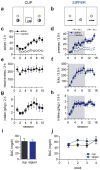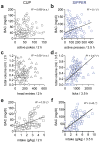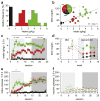Alcohol operant self-administration: Investigating how alcohol-seeking behaviors predict drinking in mice using two operant approaches
- PMID: 29310048
- PMCID: PMC5939586
- DOI: 10.1016/j.alcohol.2017.08.008
Alcohol operant self-administration: Investigating how alcohol-seeking behaviors predict drinking in mice using two operant approaches
Abstract
Alcohol operant self-administration paradigms are critical tools for studying the neural circuits implicated in both alcohol-seeking and consummatory behaviors and for understanding the neural basis underlying alcohol-use disorders. In this study, we investigate the predictive value of two operant models of oral alcohol self-administration in mice, one in which alcohol is delivered into a cup following nose-poke responses with no accurate measurement of consumed alcohol solution, and another paradigm that provides access to alcohol via a sipper tube following lever presses and where lick rate and consumed alcohol volume can be measured. The goal was to identify a paradigm where operant behaviors such as lever presses and nose pokes, as well as other tracked behavior such as licks and head entries, can be used to reliably predict blood alcohol concentration (BAC). All mice were first exposed to alcohol in the home cage using the "drinking in the dark" (DID) procedure for 3 weeks and then were trained in alcohol self-administration using either of the operant paradigms for several weeks. Even without sucrose fading or food pre-training, mice acquired alcohol self-administration with both paradigms. However, neither lever press nor nose-poke rates were good predictors of alcohol intake or BAC. Only the lick rate and consumed alcohol were consistently and significantly correlated with BAC. Using this paradigm that accurately measures alcohol intake, unsupervised cluster analysis revealed three groups of mice: high-drinking (43%), low-drinking (37%), and non-drinking mice (20%). High-drinking mice showed faster acquisition of operant responding and achieved higher BACs than low-drinking mice. Lick rate and volume consumed varied with the alcohol concentration made available only for high- and low-drinking mice, but not for non-drinking mice. In addition, high- and low-drinking mice showed similar patterns during extinction and significant cue-induced reinstatement of seeking. Only high-drinking mice showed insensitivity to quinine adulteration, indicating a willingness to drink alcohol despite pairing with aversive stimuli. Thus, this study shows that relying on active presses is not an accurate determination of drinking behavior in mice. Only paradigms that allow for accurate measurements of consumed alcohol and/or lick rate are valid models of operant alcohol self-administration, where compulsive-like drinking could be accurately determined based on changes in alcohol intake when paired with bitter-tasting stimuli.
Keywords: Alcohol drinking; Blood alcohol concentration; Breakpoints; Ethanol; Quinine adulteration.
Published by Elsevier Inc.
Conflict of interest statement
The authors declare no conflicts of interest.
Figures







References
-
- Augier E, Dulman RS, Singley E, Heilig M. A method for evaluating the reinforcing properties of ethanol in rats without water deprivation, saccharin fading or extended access training. Journal of Visualized Experiments. 2017;119 https://doi.org/10.3791/53305. - DOI - PMC - PubMed
-
- Augier E, Flanigan M, Dulman RS, Pincus A, Schank JR, Rice KC, et al. Wistar rats acquire and maintain self-administration of 20% ethanol without water deprivation, saccharin/sucrose fading, or extended access training. Psychopharmacology (Berl) 2014;231:4561–4568. https://doi.org/10.1007/s00213-014-3605-3. - DOI - PMC - PubMed
-
- Barak S, Liu F, Ben Hamida S, Yowell QV, Neasta J, Kharazia V, et al. Disruption of alcohol-related memories by mTORC1 inhibition prevents relapse. Nature Neuroscience. 2013;16:1111–1117. https://doi.org/10.1038/nn.3439. - DOI - PMC - PubMed
-
- Barkley-Levenson AM, Cunningham CL, Smitasin PJ, Crabbe JC. Rewarding and aversive effects of ethanol in High Drinking in the Dark selectively bred mice. Addiction Biology. 2015;20:80–90. https://doi.org/10.1111/adb.12079. - DOI - PMC - PubMed
-
- Bertholomey ML, Verplaetse TL, Czachowski CL. Alterations in ethanol seeking and self-administration following yohimbine in selectively bred alcohol-preferring (P) and high alcohol drinking (HAD-2) rats. Behavioural Brain Research. 2013;238:252–258. https://doi.org/10.1016/j.bbr.2012.10.030. - DOI - PMC - PubMed
Publication types
MeSH terms
Substances
Grants and funding
LinkOut - more resources
Full Text Sources
Other Literature Sources
Medical

